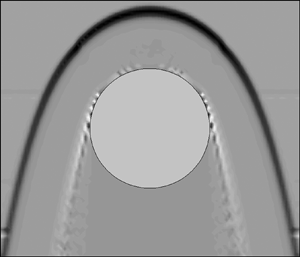Article contents
A numerical investigation of granular shock waves over a circular cylinder using the discrete element method
Published online by Cambridge University Press: 07 February 2022
Abstract

Numerical simulation based on the discrete element method (DEM) is used to investigate the flow field generated when a cylindrical obstacle is placed in a supersonic granular stream. Robust validation of the simulation model is performed by comparing numerical results with experiments. Experiments are performed using a two-dimensional set-up generating rapid granular flow owing to gravity. DEM simulations demonstrate that a rapid gas-like stream of grains suddenly decelerates across the shock wave and finally collapses into a slow-moving heap at the cylinder. The volume fraction suddenly increases across the shock layer and remains constant thereafter. The flow physics of the shock wave and the granular heap is elucidated through fundamental fluid dynamic quantities such as the velocity, volume fraction, pressure and granular temperature. It is shown that the interaction of grains with a cylindrical obstacle results in the generation of pressure, which is responsible for sustaining static granular heaps on the cylinder. The total pressure is resolved into collisional and streaming components. A streaming pressure is generated owing to velocity fluctuations, and is found to be significant only in the shock wave region. The observations show that the rheological complexity offered by granular shock waves is a direct manifestation of the dissipative and frictional nature of granular collisions. The new insight into the granular heaps could be relevant to a variety of applications involving granular-fluid–solid interactions.
JFM classification
- Type
- JFM Papers
- Information
- Copyright
- © The Author(s), 2022. Published by Cambridge University Press
References
REFERENCES
- 5
- Cited by





